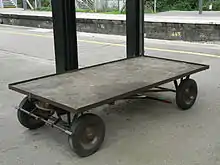Flatbed trolley
A flatbed trolley, or dray, a common form of freight transport in distribution environments, for moving bulk loads. A very simple design offers a basic flat platform with four casters and a fixed handle which is used to either push or pull the platform with the load on the platform. Without a flat surface it becomes an "open frame" trolley and without a handle it is a bogie or dolly.[1]

The frame is usually fabricated steel. The primary flatbed surface can be constructed from wooden boards, plastic, steel or mesh. Flatbed casters can vary dramatically, made of solid rubber, air filled pneumatic or cast iron. The caster is generally the component on the flatbed trolley that limits the safe working capacity.
The term dray is also used to refer to a truck with no sides.[2]
Specialised trolleys include the piano dolly, which features a stronger-than-usual frame.[3] The "U-boat" – used to move and stock goods by retailers such as grocery stores – has two high handles on opposite ends of a thin flatbed. Modern factory systems commonly track individual trolleys digitally to facilitate automated bills of lading; automated systems may have remotely operated or autonomous trolleys for transport during storage and access.[4]
The trolley shown at right is termed "a turntable trolley" due to its steering mechanism. Unlike a flatbed trolley that is mounted on castors, turntable trolleys are mounted on solid axles which allows a much higher load capacity. The rear axles are fixed to the chassis, and the front wheels are attached to a steering mechanism that allows the trolley to be turned when moved.
See also
References
- Fazio, Larry (July 23, 2000), Stage manager: the professional experience, Focal Press, p. 303, ISBN 978-0-240-80410-1
- "Dray". Lexico Dictionaries English. Retrieved 5 August 2020.
- "Dolly facilitates piano moving", Popular Mechanics, Hearst Magazines, 49.3: 524, 1928, ISSN 0032-4558
- Kendall, Kenneth E.; Kendall, Julie E. (2008), Systems analysis and design (7 ed.), Pearson/Prentice Hall, ISBN 978-0-13-224085-7